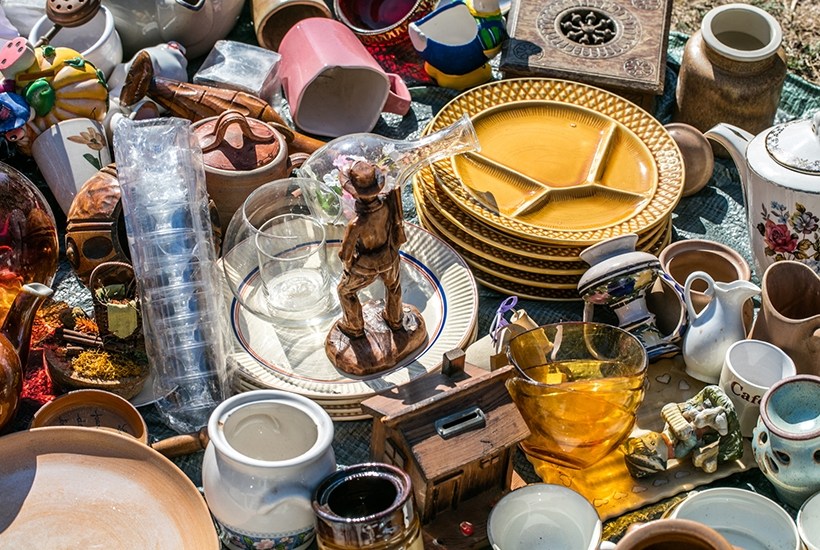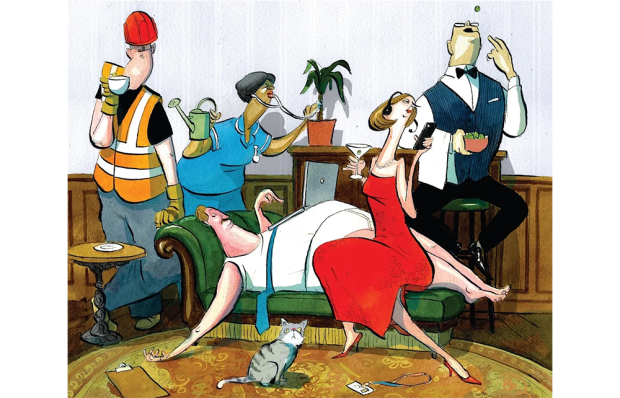When everything re-opened after the first lockdown, I didn’t immediately head to a restaurant, bar or hairdresser. I went to the Second Chance charity shop on Blackstock Road in north London. It wasn’t that I was feeling particularly charitable. If anything, my visit came from a place of selfishness. I wanted to rootle around, alone, and find something unexpected — and probably pointless — in the piles of bric-à-brac. Out I came with a milk jug (£2.50) and a book titled Cool Names for Babies (50p) written by two women called Pamela Redmond Satran and Linda Rosenkrantz. I instantly felt better, as though the past few months had been a bad dream.
I can’t be the only person who has missed this sort of experience. Anyone who loves charity shops will appreciate they offer a unique thrill. You might come out with a highly useful item you would have bought for far more elsewhere, or you could discover a totally useless trinket to be smuggled back home. The charitable aspect is by the by, really, although it does help to know that you’re supporting elderly veterans or down-at-heel donkeys when buying more clutter.
Britain is now a nation of charity shoppers. Our great achievement is to have turned scavenging into a benevolent activity. According to the Charities Aid Foundation, 88 per cent of us have bought something from one. They seem to be distinctly British (the first was founded in 1899 in Wolverhampton to help raise funds for the blind), although a few other Anglophone countries have them: in New Zealand and Australia, they are known as ‘op shops’. Americans call them ‘thrift shops’ but many make a profit, which isn’t really the point. The French prefer to do their second-hand shopping via stylish brocante fairs or a vide-grenier: the Gallic version of the car boot sale. I imagine many Europeans regard our musty charity shops as peculiar and more than a little gross (‘dead people’s clothes’, says a French friend). And possibly they are right.
They have a mixed reputation here, too. Some imagine them to be manky dumpinggrounds for old bras and sticky recipe books, which they often are. Others — like my pal Clemmie — consider them joyous places, and will seek them out wherever they find themselves in the UK. During lockdown, Clemmie and I reminisced about our notable victories. I am proud of the enamel bread bin I found for £4 in Crisis a few years ago. But when Clemmie revealed she had once picked up a pair of Ray-Ban Wayfarers in a Hospice in the Weald shop in Tunbridge Wells for 75p, I was deeply envious.
Each year, British charity shops raise around £300 million. This year they won’t have raised nearly as much because of the pandemic. Oxfam — which has 595 shops around the UK — has said its sales are down by almost a third. The British Heart Foundation has lost around £60 million. Unless every-one has been quietly donating the same amount they’d usually spend in the shops directly to the individual charities (I know I haven’t been), many will have big holes in their finances.
Before charity shops were forced to close again for the second lockdown, I noticed signs going up in some of their windows saying they could no longer accept donations. I asked one volunteer why this was. Because of the virus, the elderly lady said, donations now need to be isolated for a few days and then cleaned more thoroughly. This is making life tricky for the staff, and risks causing a pile-up behind the scenes.
Many places have been deluged by stuff, which is both a blessing and a curse. Who hasn’t done some decluttering during lockdown? We have been encouraged to banish items which no longer ‘spark joy’ by the Japanese organising consultant and cleaning enthusiast Marie Kondo. And in normal times, the shops will happily take your box of junk and ask no questions. The contents are quietly sorted, priced and tagged, often by volunteers, before being resold to help others. It is a saintly service.
Unlike Amazon — which is a destructive force. This year, I have bought more paraphernalia from Amazon than from anywhere else. I hate how reliant I have become on Jeff’s efficient, rapacious service. Every time I click the yellow button that says, ‘Buy Now’, I feel bad. But at times it seemed like the only option.
Charities have tried hard to keep up with the culture of ‘Buy Now’. Some sell their items to the highest bidder on eBay, for instance. But this is not nearly as enjoyable an experience. Competing to buy something in a nerve-wracking digital auction is very different from coming across it buried under a pile of golf tees, jam jars and scratched DVDs. I suspect the charity shop will never fare that well online, because the internet is not a particularly charitable place.
I hope charity shops survive both the onslaught of the pandemic and the internet. We associate an abundance of them with urban decline. But I reckon quite the opposite is true: they are symbols of our country’s ability to be thrifty, resourceful and, of course, charitable. Ethical without being worthy, they are defiantly the opposite of everything Amazon represents. And thankfully, they are also places — in normal times, at least — where we can deposit all the crap we bought from Jeff.
Got something to add? Join the discussion and comment below.
Get 10 issues for just $10
Subscribe to The Spectator Australia today for the next 10 magazine issues, plus full online access, for just $10.
You might disagree with half of it, but you’ll enjoy reading all of it. Try your first month for free, then just $2 a week for the remainder of your first year.















Comments
Don't miss out
Join the conversation with other Spectator Australia readers. Subscribe to leave a comment.
SUBSCRIBEAlready a subscriber? Log in